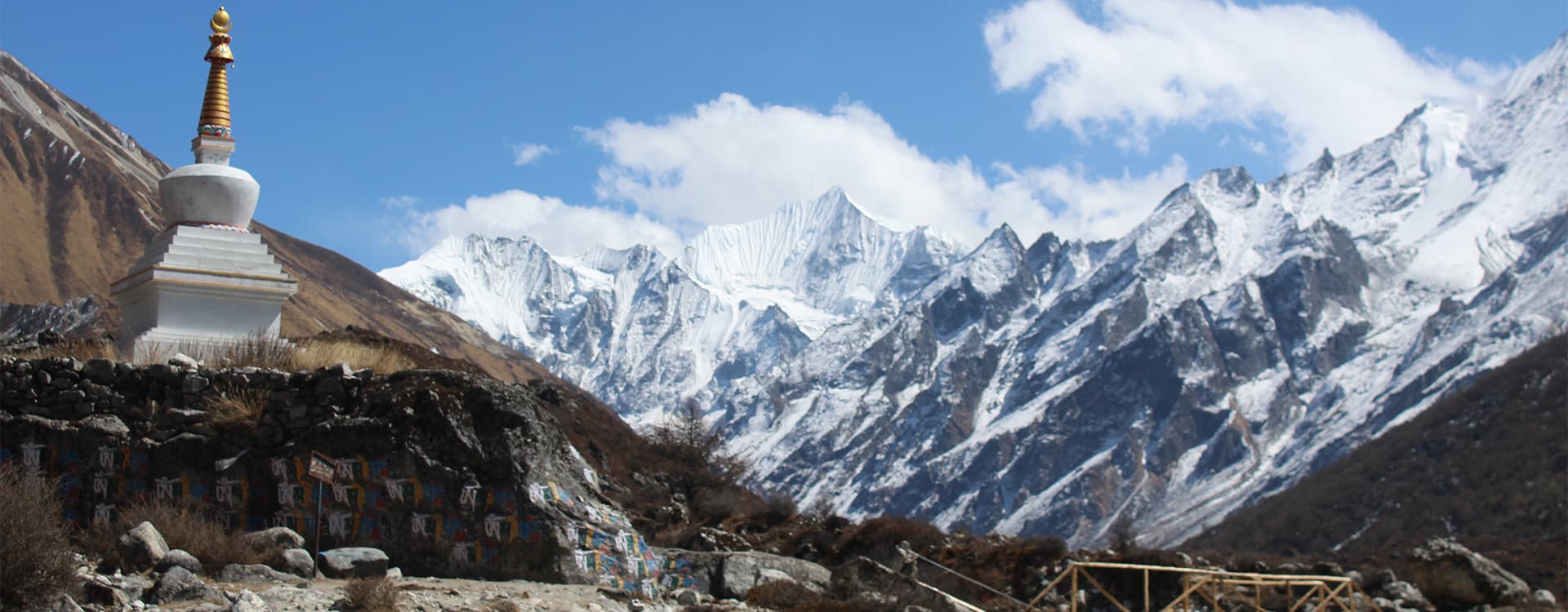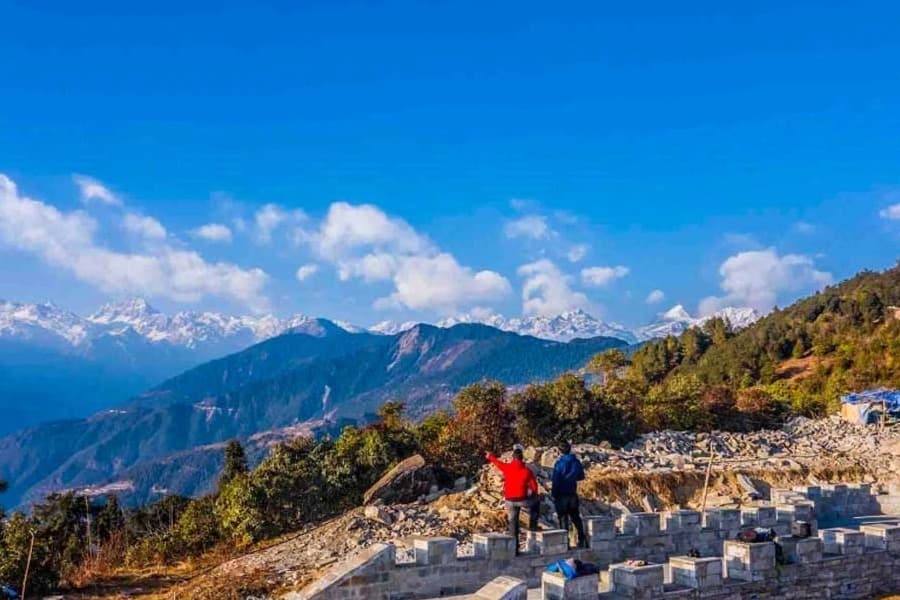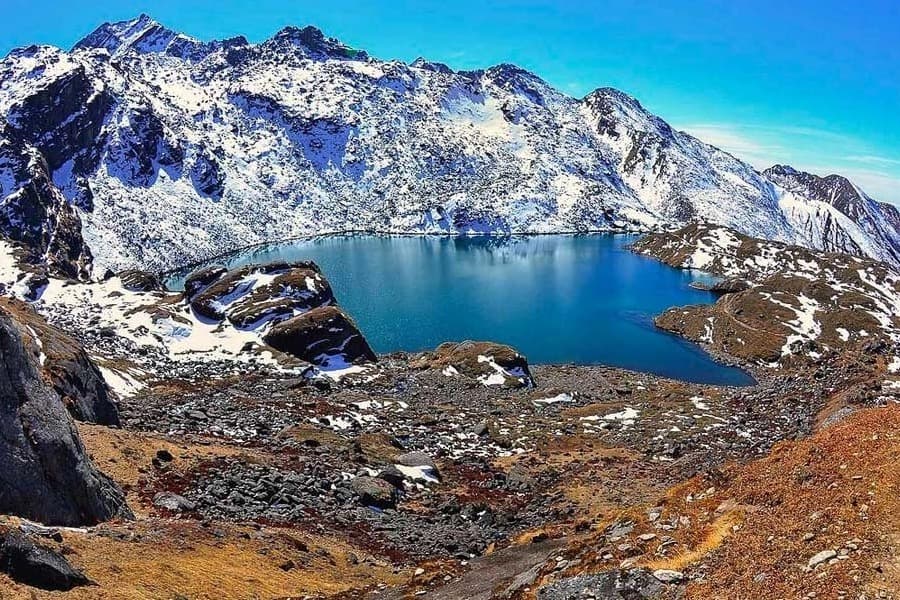Quick Facts
- Destination: Nepal
- Duration: 11 Days
- Trip Type: Trek
- Maximum Altitude: 5,033 m / 16,512 ft
- Group Size: 2 to 10+
- Best Time: Spring and Autumn
- Starting/Ending Points: Kathmandu
- Transportation: Drive from Kathmandu to Syabru Besi and Syabru Besi to Kathmandu
The Langtang Valley Trek is one of the closest treks that can be done from Kathmandu. The Langtang region is located to the north of Kathmandu and the valley borders Tibet. Situated in the Rasuwa District of Kathmandu, the area is also home to Langtang National Park.
The hike to Langtang became famous as people explored the Kyanjin Ri, located at an altitude of 4,773 m. The peak provides 360 degree views of the snow capped mountains like Mt. Dorje Lakpa, Mt. Langtang Lirungand and other Himalayas that represent the Langtang mountain range.
The trekking trails to Langtang Valley are covered with several landmarks, among which the Kanjing Gompa is popular. In Kyanjin Gompa, you will be able to explore old Buddhist monasteries and try out the local cheese, which is famous in the entire region.
The 11 day journey is a great opportunity for you to explore the local culture and lifestyles of the people. The trip takes you to several local villages, like Syabru Besi, Kanjing Gompa, Lama Hotel and Langtang Village. All of these villages have a unique blend of culture and traditions, with Tamang and Sherpa people majorly inhabiting the area.
Throughout the Lantang Valley trip, you will be able to see a diverse range of flora and fauna along your trails. Sal forest mostly covers the vegetation of this region and is home to the rare Nepalese larch. The region is also home to several wildlife species, like the red panda, the Himalayan black bear, the snow leopard, the musk deer, the Himalayan tahr, and the rhesus monkey.
The 11 day Langtang voyage begins in Kathmandu with a drive to Syabru Besi, offering scenic views of snow-capped peaks and passing through villages like Dhunche. Trekking from Syabru Besi to Lama Hotel on day two involves crossing a bridge over the Langtang River and ascending through terraced fields and villages.
On day three, you will hike to Langtang village through dense forests and a picturesque gorge. On day four, you will head to Kyanjing Gompa for a short, steep climb. After acclimatization at Kyanjing Gompa, you will return to the Lama Hotel on day six and descend back to Syabru Besi. The journey concludes with a drive back to Kathmandu on day nine.
What to expect during the Langtang Adventure?
A fully immersing experience in Nepal's breathtaking scenery and vibrant culture is what Langtang Adventure offers. You can expect to see a wide variety of scenery during ten days, from lush woods and terraced farms to rocky gorges and mountainous settings. The trip starts with a drive through scenic settlements like Dhunche and views of snow-capped hills to Syabru Besi.
On the entire journey, you can expect a lot of cultural encounters with people. As the route of the trip takes you to villages like Lama Hotel, Kyanjing Gompa and more, you will get to see the day to day lives of people and their cultures. This will be a great opportunity for you to build a cultural understanding of the people living in the Himalayan region.
Not only that, but you will also get breathtaking views of the Himalayan peaks. If you are a photography or nature lover, then the adventure offers you a natural haven. You can expect this journey to be a perfect blend of cultural immersion and natural beauty.
Passing through old Buddhist monasteries, you will also be able to see the significance that these monasteries hold for their culture and history. All in all, expect a journey to the Valley of Langtang filled with adventure and thrills.
Mountains Viewed While Trekking to Langtang Valley
The journey offers you stunning views of some of the world’s most breathtaking mountains. Throughout the hike, you will see mountains like Langtang Lirung (7,227 m / 23,711 ft), Ganesh Himal (7,406 m / 24,296 ft), Dorje Lakpa (6,966 m / 22,854 ft), Ganjala Himal (5,130 m / 16,830 ft), Yala Peak (5,732 m / 18,806 ft), and Tserko Ri (5,033 m / 16,500 ft).
The tallest mountain in the Langtang Himal range, towering Langtang Lirung, is situated at an amazing elevation of 7,227 meters (23,711 ft). As you continue into the Langtang Valley, the spectacular snow-capped top of this mountain dominates the skyline.
The Langtang Valley looks even more beautiful with the Ganesh Himal mountains in the background. These mountains are named after the Hindu god Ganesh. As you hike further, you'll see peaks like Ganesh I, Ganesh II, Ganesh III, and Ganesh IV.
Dorje Lakpa is another notable peak that can be seen from the Langtang Valley. Hikers find it to be a stunning sight with its unique pyramid-shaped peak and slopes covered with glaciers. You can see the Ganjala Himal range as you go towards Kyanjin Gompa. You will enjoy breathtaking views of this range's peaks, such as Langshisha Ri and Nayakang Peak, which rise sharply out of the terrain.
Yala Peak is also a well-liked trekking destination in the Langtang area. Trekkers frequently get a close-up look at this snow-capped summit as they pass through the Langtang Valley due to its proximity to the valley. Tserko Ri is a popular spot you can reach by walking a bit from Kyanjin Gompa. From there, you can see wide views of Langtang Lirung, other peaks, and the Langtang Himalaya around you.
Rich Flora and Fauna of Langtang Region
Nepal’s Langtang region is known for its stunning landscapes as well as its rich biodiversity. The valley has a diverse range of flora and fauna and provides you with the opportunity to immerse yourself in the ecosystem.
Flora
The Langtang region's vegetation consists of high-altitude shrublands, alpine meadows, and lush woods. The lower altitude is covered with dense oak and rhododendron forests. In the spring, these forests blossom with colorful flowers that cover the slopes in shades of red, pink, and white.
You will find yourself in subalpine and alpine zones as you move deeper into the mountains. Here, you will see juniper, pine, and fir trees hanging from steep slopes, mixed with patches of vibrant alpine flowers like gentians, primroses, and edelweiss.
Fauna
There is also a wide variety of fauna in the Langtang area, including some rare and endangered species. The endangered red panda and the elusive snow leopard, which live in the isolated and rugged landscape of the high mountains of the area, are two of its most famous wildlife.
The Himalayan tahr, musk deer, Himalayan black bear, and Himalayan serow are some of the other creatures that can be seen wandering the woods and alpine meadows.
A wide range of bird species can also be seen.
These include the vibrant Himalayan monal, blood pheasant, lammergeier, and many types of vultures, falcons, and eagles. The region is also home to 70 butterfly species and 373 species of birds in total.
Cost of Langtang Valley Trek for 2024 and 2025
The cost of the Langtang trek includes all the necessary permits, transportation, accommodation, meals, experienced and highly trained guides, and arrival and departure transfers.
Please note that the price of the package for the Langtang Trek might vary depending on the customization. We provide a customization service where you can modify the itinerary as per your needs and requirements. The cost will vary depending on the modifications and add ons.
Best Season for Langtang Valley Trip
The ideal times to go on the Langtang trek in Nepal are in the spring and fall.
Spring (March to May): The scenery is bright and colorful during this season due to the blossoming rhododendrons and the moderate temperatures. Generally, bright skies provide breathtaking views of the nearby Himalayas. As so many migrating birds return to the area in the spring, it's also a terrific time to go bird-watching.
Autumn (September to November): This is the busiest time of year for trekking in Nepal, especially in the valley. Traveling is ideal due to the consistent weather, which consists of bright skies and comfortable temperatures. The Himalayan views are stunning, and the routes are often dry and give adequate grip.
With proper planning and preparation, this journey can also be done during the winter as well as the monsoon season. However, it is usually not recommended that you do the trek during off seasons like the winter and monsoon seasons, given the harsh and unpredictable weather patterns.




